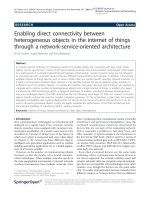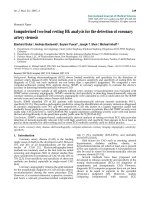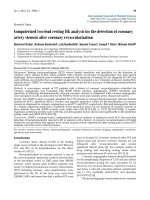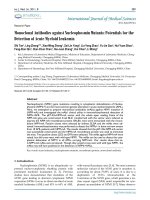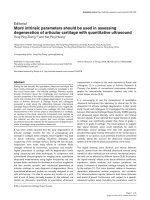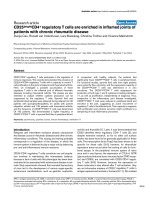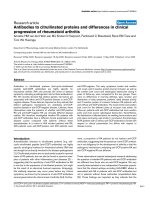Báo cáo y học: "Automatic versus manual pressure support reduction in the weaning of post-operative patients: a randomised controlled trial" pdf
Bạn đang xem bản rút gọn của tài liệu. Xem và tải ngay bản đầy đủ của tài liệu tại đây (637.35 KB, 9 trang )
Open Access
Available online />Page 1 of 9
(page number not for citation purposes)
Vol 13 No 1
Research
Automatic versus manual pressure support reduction in the
weaning of post-operative patients: a randomised controlled trial
Corinne Taniguchi
1
, Raquel C Eid
1
, Cilene Saghabi
1
, Rogério Souza
2
, Eliezer Silva
1
, Elias Knobel
1
,
Ângela T Paes
1
and Carmen S Barbas
1,2
1
Adult – ICU – Albert Einstein Hospital, Av. Albert Einstein 627-5 andar – São Paulo, SP, 05651-901, Brazil
2
Pulmonary Division, University of São Paulo, Av Dr Eneas de Carvalho Aguiar 255-room 7079, São Paulo, SP, 05403-900, Brazil
Corresponding author: Carmen S Barbas,
Received: 26 Jun 2008 Revisions requested: 15 Sep 2008 Revisions received: 20 Oct 2008 Accepted: 26 Jan 2009 Published: 26 Jan 2009
Critical Care 2009, 13:R6 (doi:10.1186/cc7695)
This article is online at: />© 2009 Taniguchi et al.; licensee BioMed Central Ltd.
This is an open access article distributed under the terms of the Creative Commons Attribution License ( />),
which permits unrestricted use, distribution, and reproduction in any medium, provided the original work is properly cited.
Abstract
Introduction Reduction of automatic pressure support based
on a target respiratory frequency or mandatory rate ventilation
(MRV) is available in the Taema-Horus ventilator for the weaning
process in the intensive care unit (ICU) setting. We
hypothesised that MRV is as effective as manual weaning in
post-operative ICU patients.
Methods There were 106 patients selected in the post-
operative period in a prospective, randomised, controlled
protocol. When the patients arrived at the ICU after surgery,
they were randomly assigned to either: traditional weaning,
consisting of the manual reduction of pressure support every 30
minutes, keeping the respiratory rate/tidal volume (RR/TV)
below 80 L until 5 to 7 cmH
2
O of pressure support ventilation
(PSV); or automatic weaning, referring to MRV set with a
respiratory frequency target of 15 breaths per minute (the
ventilator automatically decreased the PSV level by 1 cmH
2
O
every four respiratory cycles, if the patient's RR was less than 15
per minute). The primary endpoint of the study was the duration
of the weaning process. Secondary endpoints were levels of
pressure support, RR, TV (mL), RR/TV, positive end expiratory
pressure levels, FiO
2
and SpO
2
required during the weaning
process, the need for reintubation and the need for non-invasive
ventilation in the 48 hours after extubation.
Results In the intention to treat analysis there were no
statistically significant differences between the 53 patients
selected for each group regarding gender (p = 0.541), age (p =
0.585) and type of surgery (p = 0.172). Nineteen patients
presented complications during the trial (4 in the PSV manual
group and 15 in the MRV automatic group, p < 0.05). Nine
patients in the automatic group did not adapt to the MRV mode.
The mean ± sd (standard deviation) duration of the weaning
process was 221 ± 192 for the manual group, and 271 ± 369
minutes for the automatic group (p = 0.375). PSV levels were
significantly higher in MRV compared with that of the PSV
manual reduction (p < 0.05). Reintubation was not required in
either group. Non-invasive ventilation was necessary for two
patients, in the manual group after cardiac surgery (p = 0.51).
Conclusions The duration of the automatic reduction of
pressure support was similar to the manual one in the post-
operative period in the ICU, but presented more complications,
especially no adaptation to the MRV algorithm.
Trial Registration Trial registration number: ISRCTN37456640
Introduction
The weaning of mechanical ventilation or the removal of
mechanical ventilation involves preparation of the patient and
the progressive reduction of the ventilatory aid. As soon as the
patients re-assume their capability to breathe on their own, the
weaning process starts. The success of the weaning depends
more on the patients' ventilatory capability than on the demand
of the patient. In this manner, many factors need to be consid-
ered for weaning success: an adequate level of conscious-
ness and respiratory drive; an adequate gas exchange with
progressive decrement of the inspiratory and expiratory respi-
ratory pressures; preserved respiratory muscle function and
ANOVA: analysis of variance; BPM: breaths per minute; CI: confidence interval; CPM: cycles per minute; FiO
2
: fraction of inspired oxygen; ICU: inten-
sive care unit; IQR: interquartile range; MRV: mandatory rate ventilation; PEEP: positive end-expiratory pressure; PS max: pressure support maximum;
PSV: pressure support ventilation; RR: respiratory rate; SD: standard deviation; SpO
2
: arterial oxygen saturation; TV: tidal volume
Critical Care Vol 13 No 1 Taniguchi et al.
Page 2 of 9
(page number not for citation purposes)
mechanics; and no severe metabolic or hydro-electrolytic dis-
turbance [1].
The most popular weaning methods used are pressure sup-
port ventilation (PSV) and T-tube. Weaning through the T-tube
is simpler but has some disadvantages such as the lack of an
end expiratory pressure; the harsh change of the ventilation
assistance; the lack of oxygen delivery control; and the lack of
a proper ventilatory monitor [1]. One randomised controlled
trial showed a superiority of the T-tube in relation to PSV and
the necessity of a T-tube once a day to accelerate the weaning
process [2,3]. Another controlled and randomised weaning
trial has shown the superiority of PSV compared with T-tube
and synchronised intermittent mandatory ventilation [4]. An
attempt at PSV was made once a day and pressure support
ventilation efficiently reduced the workload imposed on the
respiratory muscles. The level of assistance can be gradually
decreased until it only compensates for the additional work
imposed by the endotracheal tube and the demand valve of
the ventilator, at which time tracheal extubation can be per-
formed. It can be used in association with positive end expira-
tory pressure (PEEP) and monitoring. Ely and colleagues [5]
have shown that a daily attempt at spontaneous ventilation
reduces the mechanical ventilation period. Smyrnios and col-
leagues [6] concluded that it was of great importance to iden-
tify and resolve the patients' weaning problems quickly, which
is possible through systematic medical access to an organ-
ised multidisciplinary system of work. The prolongation of
mechanical ventilation can lead to an increased risk of ventila-
tion-associated pneumonia [7,8]; on the other hand, prema-
ture extubation followed by reintubation can increase the
morbidity and mortality [9]. The major goal is to recognise
readiness for extubation as soon and as reliably as possible
[10]. Studies have shown that the duration of mechanical ven-
tilation depends on a systematic approach in the weaning
period for reducing the level of assistance and testing the pos-
sibility to resume spontaneous breathing [5,11,12].
The pressure support approach in mechanical ventilation
weaning is designed to set the PSV mode to a level high
enough to achieve a tidal volume (TV) of 8 mL/kg. This level of
PSV is progressively reduced until a level of between five and
seven is reached in accordance with the evaluation of the res-
piratory rate (RR), usage of accessory muscles and by the
index RR/TV [13-18]. The reduction of the pressure support
level can be made manually (by the physician or respiratory
therapist) or automatically (by the ventilator itself according to
an algorithm).
Automatic and computerised weaning using pressure support
is based on an algorithm in the mandatory rate ventilation
(MRV). This mode was first used in 1988 and consists of a
ventilation mode that automatically decreases the PSV based
on the RR target, during the weaning process. The RR target
value represents the RR that the patient is expected to per-
form. In each cycle, the ventilator compares the RR target with
the average RR, which was obtained from the last four cycles,
with the limit ± three cycles per minute (CPM). If the average
RR is higher than the RR target, the PSV will automatically be
raised by 1 cmH
2
O. If the average RR is lower than the RR tar-
get, the PSV will automatically be decreased by 1 cmH
2
O.
With an adequate PSV level the work of breathing decreases.
If the PSV is overset, TV increases, work of breathing
decreases and the RR will also decrease.
There is an inverse relationship between the PSV and the RR.
Thus, this ventilation mode uses the RR as a parameter to
adjust the PSV automatically. In this way, it is considered a
safe ventilatory mode for stable patients [19,20]. When the
PSV is adjusted correctly, the RR will be between 15 and 25
breaths per minute (bpm) physiologically, and the patient will
breathe comfortably. Levels of PSV less than the patient
requires will produce an increase in the work of breathing and
an increase in RR. The opposite can also occur causing
apnoea in the patient.
Chopin and Chambrin [21] alert us to the residual effect of the
anaesthetics, which can reduce the RR, reducing the PSV pre-
cociously, and the minute ventilation which will lead to hypov-
entilation. However, there is a back up ventilation mode
associated with MRV. The algorithm of MRV is based on the
target RR. Our group wanted to test this algorithm in clinical
practice to verify if the algorithm works with post-operative
patients aiming to automatically wean these patients in our
intensive care unit (ICU), thus facilitating the ICU routines.
We therefore hypothesised in this study that weaning with
MRV is as fast and secure as the manual decrement of PSV
during a weaning trial in the post-operative ICU mechanically
ventilated patient.
The purpose of this study is to compare two methods of wean-
ing from mechanical ventilation, using a prospective, ran-
domised and controlled protocol. A comparison is made
between weaning from PSV system by an automatic and com-
puterised method (MRV) and the manual method of weaning,
guided by the intensive care unit (ICU) staff, with regard to the
time needed for the weaning process and the need of reintu-
bation or non-invasive ventilation in post-operative patients.
Materials and methods
We evaluated 158 postoperative patients admitted to the
Albert Einstein Adult ICU in São Paulo, Brazil, who were over
the age of 18 years, receiving mechanical ventilation after car-
diac, thoracic, abdominal or orthopaedic surgery, from August
2002 to January 2004. We excluded patients who had neuro-
logical surgeries to avoid variations in the minute-ventilation in
this patient population and patients with previous pulmonary
disease or haemodynamic instability during the weaning of
mechanical ventilation.
Available online />Page 3 of 9
(page number not for citation purposes)
The study was approved by the ethical committee of our insti-
tution (CONEP-BRAZIL number 372/06) and was registered
in ISRCTN-org as number 37456640. Signed informed con-
sent was obtained from each patient or next of kin.
When the patients arrived at the intensive care unit (ICU), they
were still under the effect of the sedatives and under control-
led ventilation. Therefore, to randomise patients, we randomly
drew folded slips of paper from a large envelope. Each slip of
paper provided an identification number and the assigned
weaning method. Group I was manual weaning, guided by the
ICU staff, ventilated with the Servo 900C
®
ventilator (Maquet,
Germany). Group II was MRV, automatic, computerised wean-
ing, ventilated with the Taema-Horus Ventilator
®
(Air Liquid,
France) (Figure 1).
Group I was ventilated with a level of pressure controlled ven-
tilation sufficient for a TV of 8 mL/kg; with a RR of 15 bpm;
inspired oxygen fraction (FiO
2
) enough for oxygen saturation
(SpO
2
) higher than 95%; PEEP of 5 cmH
2
O. Group II was
ventilated using the same parameters of pressure-controlled
ventilation, except that to obtain a respiratory rate of 15 bpm,
in this mode, we set target RR as 15 bpm and the minimum
respiratory rate as 15 bpm. This gave us the same parameters
of ventilation in group I and II while the patient was recovering
from the effects of sedation.
When the patient started breathing spontaneously we then set
the mode for PSV.
Group I was ventilated with a level of PSV enough for a TV of
8 mL/kg; with the index RR/TV less than 80 L; FiO
2
enough for
SpO
2
higher than 95%; PEEP of 5 cmH
2
O. The PSV was
reduced every 30 minutes, by the ICU staff, keeping RR/TV
less than 80 L and TV enough for 8 mL/kg. PSV could be reas-
sessed and possibly decreased every 30 minutes aiming to
make the manual weaning as close as possible to the auto-
matic algorithm. Group II was ventilated with a level of PSV
enough for TV of 8 mL/kg; with pressure support maximum
(PS max) of 25 cmH
2
O; target RR of 15 bpm; minimum RR of
8 bpm; FiO
2
enough for SpO
2
higher than 95%; PEEP of 5
cmH
2
O. Setting the ventilator as above, in the MRV mode, the
automatic reduction of PSV started.
In both groups, after each period of 30 minutes, the following
data set was collected: level of PSV, RR, TV, RR/TV, FiO
2
,
SpO
2
and PEEP as far as the PSV level between 5 and 7. If
the patient remained stable (without arrhythmias or haemody-
namic instability), had adequate mental status and was capa-
ble of protecting the airway, with PSV between 5 and 7, PEEP
of 5, FiO
2
of 40%, SpO
2
above 95%, RR/TV less than 80 L,
they would be extubated. After the removal of the mechanical
ventilation, the patients were observed for 48 hours to assess
the need for reintubation or noninvasive ventilation.
The ICU co-interventions remained similar in both arms of the
protocol during the study (sedation, analgesia, antibiotics,
vasoactive drugs, if necessary) following our ICU standard of
care routines.
Endpoints
The primary endpoint was the duration of the weaning proc-
ess, from the moment the patient started to breathe spontane-
ously until successful extubation. Secondary endpoints were:
levels of pressure support, TV, RR, FiO
2
, SpO
2
, PEEP levels
and RR/VT required during the weaning process, need of rein-
tubation or need of non-invasive ventilation (Figure 1).
Statistical analysis
For estimates of sample size calculation, a pilot study was per-
formed with 40 patients that revealed a standard deviation
Figure 1
Study designStudy design. FiO
2
= fraction of inspired oxygen; MRV = mandatory
rate ventilation; PEEP = positive end-expiratory pressure; PCV = pres-
sure controlled ventilation; PSV = pressure support ventilation; RR =
respiratory rate; SpO
2
= arterial oxygen saturation; TV = tidal volume.
Critical Care Vol 13 No 1 Taniguchi et al.
Page 4 of 9
(page number not for citation purposes)
(SD) of about 100 minutes in the two studied groups. Consid-
ering a study power of 80% and a p level (two-tails) of 0.05 it
would be necessary to have 50 patients in each group to
detect a mean difference of at least 60 minutes between the
two groups.
Following the intention-to-treat principle, all randomised
patients were included in these analyses. Continuous varia-
bles were summarised as means ± SD or median and inter-
quartile ranges (IQR) when appropriate and categorical
variables as absolute frequencies and percentages. The Chi-
squared, Student's t and Wilcoxon tests were used to com-
pare the two groups regarding categorical and continuous var-
iables, respectively. In order to evaluate the respiratory
parameters variations along time, a two-way repeated measure
analysis of variance (ANOVA) was performed. The signifi-
cance level was 0.05. The statistical package used for all anal-
yses was the SPSS, version 11.0 (SPSS Inc, Chicago, IL,
USA).
Results
During the 17-month trial period, a total of 158 post-operative
ventilated patients were screened, of whom a total of 106
patients were randomised to receive the intended treatments
(53 in each study group). The characteristics of the patients
are summarised in Table 1. Both the manual and automatic
groups were similar in terms of age, gender and type of sur-
gery. In total, 19 patients presented complications during the
trial, four in the manual group (two because of haemodynamic
instability; one because of apnoea and hypotension; one
because of a refusal to participate in the study) and 15 in the
automatic group (six patients because of haemodynamic insta-
bility; seven patients because the maximum PSV was reached;
two patients because the PSV did not decrease). In the man-
ual group the complications were equivalent to 7.5% of the
group and in the automatic group they were equivalent to
28.3% of the group. According to the chi-squared test there
was a significant difference between the two groups (p =
0.05). Therefore, 49 patients concluded the study in the man-
ual group and 38 in the automatic group.
In the intention-to-treat analysis the mean duration of weaning
until successful extubation was 221.04 minutes ± 192.07
minutes (minimum 30 minutes, maximum 840 minutes) in the
manual group. The weaning duration of the automatic group
was 271.32 minutes ± 369.38 minutes (minimum 30 minutes
and maximum 2520 minutes). There was no statistic differ-
ence between the two groups (p = 0.375), the mean differ-
ence between the two groups was 50 minutes with the 95%
confidence interval (CI) (-163 to 62) showing no superiority of
automatic weaning. The median duration of weaning was 170
minutes (IQR 97.5 to 265 minutes) in the manual group and
168 minutes (IQR 90.5 to 330 minutes) in the automatic
group (p = 0.777; Figure 2).
Comparing decrement of pressure support in the automatic
group to that of the manual mode we observed that the pres-
sure support guided by the RR was significantly higher during
the first three hours of the weaning period (p < 0.001 ANOVA;
Figure 3).
The mean TV of both groups varied between 537 and 602 mL/
kg. There was also no statistical difference between the two
groups during the weaning period up to the point of success-
ful extubation (p = 0.31; Figure 4).
The RR started at about 15 to 16 bpm in both groups. There
was no difference between the two groups in the first 180 min-
utes of weaning (p = 0.87; Figure 5)
Table 1
Patients' characteristics
Total Manual Automatic
Age, years 61 ± 13 61 ± 13 62 ± 14
Sex, M/F 69/37 36/17 33/20
Type of surgery
Cardiac 41 (38.7%) 15 (28.3%) 26 (49.1%)
Thoracic 5 (4.7%) 3 (5.7%) 2 (3.8%)
Abdominal 52 (49.1%) 31 (58.5%) 23 (39.6%)
Others 8 (7.5%) 4 (7.5%) 4 (7.5%)
TOTAL 106 (100%) 53 (100%) 53 (100%)
Values of age are mean ± standard deviation. Values of gender are
the number of patients of each group. In brackets are the
percentages of patients in total and in each group.
Figure 2
Boxplot of the median duration of weaning in manual and automatic weaning modesBoxplot of the median duration of weaning in manual and automatic
weaning modes.
Available online />Page 5 of 9
(page number not for citation purposes)
The mean FiO
2
during the weaning protocol was similar in both
groups with a variation of 32% to 35% (p = 0.37). However,
the effect of time was significant (p = 0.03) in both groups
showing that the FiO
2
decreased significantly in both groups
during the first 180 minutes of the weaning process (Figure 6).
The SpO
2
was maintained above 95% in both groups during
the study period. (p = 0.16).
The PEEP value was maintained at about five to six in both
groups throughout the weaning period (p = 0.06).
The RR/TV index mean value varied from 27 to 31 L in the
automatic group and from 28 to 33 L in the manual group dur-
ing the study (p = 0.78; Figure 7).
No patient needed reintubation. Two patients needed non-
invasive ventilation in the manual group after cardiac surgery
(p = 0.51). We did not observe any serious adverse events in
either of the groups.
Complementary analysis
Nineteen patients presented complications during the wean-
ing protocol. Four patients from the manual group and 15
Figure 3
Pressure support ventilation (PSV) level variation throughout weaningPressure support ventilation (PSV) level variation throughout weaning.
Each PSV refers to increments of 30 minutes in the weaning process.
There was a significant difference between the automatic mode and the
manual mode of weaning (p < 0. 01). The numbers at the bottom of the
figure refer to the number of patients that stayed in the weaning trials
through time.
Figure 4
Variation of tidal volume throughout weaningVariation of tidal volume throughout weaning. Each tidal volume value
refers to increments of 30 minutes in the weaning process. There was
no significant difference between the automatic mode and the manual
mode (p = 0.31). The numbers at the bottom of the figure refer to the
number of patients that stayed in the weaning trials through time.
Figure 5
Variation of respiratory rate throughout weaningVariation of respiratory rate throughout weaning. Each respiratory rate
value refers to increments of 30 minutes in the weaning process. There
was no difference between the automatic mode and the manual mode
(p = 0.86). The numbers at the bottom of the figure refer to the number
of patients that stayed in the weaning trials through time. bpm =
breaths per minute
Figure 6
Variation in fraction of inspired oxygen (FiO
2
) throughout weaningVariation in fraction of inspired oxygen (FiO
2
) throughout weaning.
Each FiO
2
value refers to increments of 30 minutes in the weaning
process. There was no significant difference between the automatic
mode and the manual mode (p = 0.37). The numbers at the bottom of
the figure refer to the number of patients that stayed in the weaning tri-
als through time. Decrement of FiO
2
in both groups along time (p =
0.028)
Critical Care Vol 13 No 1 Taniguchi et al.
Page 6 of 9
(page number not for citation purposes)
patients from the automatic group (p < 0.05). Nine patients in
the automatic group, or MRV, did not adapt to the set MRV
algorithm. Trying to better understand why there was no
adjustment to the MRV, we did a complementary analysis of
those nine patients. The patients stayed in the MRV for 137 ±
135 minutes (95% CI = 5 to 450 minutes) before the staff
decided to move to PSV. The weaning mean time of these nine
patients was 329 ± 150 minutes (95% CI = 168 to 642 min-
utes), as shown in Table 2. This weaning duration process was
greater than the weaning duration of the 39 patients that were
well adapted to the MRV (157 ± 130 minutes; p = 0.0012).
Discussion
In this study, we evaluated the clinical suitability of a computer-
driven automatic weaning system compared with the manual
reduction of a PSV system in the postoperative period in an
adult ICU. We concluded that automatic weaning is feasible
providing the ICU staff (physicians and respiratory physiother-
apists) spends this available time studying the weaning barri-
ers of the ICU mechanically ventilated patients as a
multidisciplinary team.
The computer-driven or automated weaning enables patients
to interact with the ventilator and to adapt ventilation output in
accordance with their individual and instantaneous needs
[22]. In MRV, the PSV is set depending on the value of RR
measured by the ventilator [23]. In our protocol, the duration
of the weaning period up to successful extubation was similar
to the manual group; however, the levels of pressure support
were constantly higher in the automatic group than in the man-
ual group. In order to keep the target RR at 15 bpm, the auto-
matic algorithm chose levels of pressure support higher than
those of the staff set by the RR/VT value (less than 80 L) in the
manual group.
Lellouche and colleagues [10] in a multi-centre randomised
trial showed that a computer-driven weaning protocol for
patients admitted for more than 24 hours to the ICU, reduced
mechanical ventilation duration and ICU length of stay, as
compared with a physician-controlled weaning process. In
contrast to this study, Rose and colleagues [24], in a recently
published randomised controlled trial, found no benefit in
using automatic weaning in a patient population made up pre-
dominantly of trauma and surgical patients. In our protocol we
Figure 7
Variation of respiratory rate (RR)/tidal volume (TV) throughout weaningVariation of respiratory rate (RR)/tidal volume (TV) throughout weaning.
Each RR/TV refers to increments of 30 minutes in the weaning proc-
ess. There was no significant difference between the automatic mode
and the manual mode (p = 0.78). The numbers at the bottom of the fig-
ure refer to the number of patients that stayed in the weaning trials
through time.
Table 2
Details of nine patients excluded from the automatic group because of a lack of adaptation to mandatory rate ventilation
Patients Type of surgery Time from the respiratory effort to change to PSV (minutes) Weaning duration (minutes)
1 Cardiac 60 228
2 Abdominal 90 258
3 Abdominal 60 288
4 Tracheoplasty 150 222
5 Cardiac 60 168
6 Burn debridement 6 330
7 Abdominal 450 642
8 Abdominal 240 330
9 Abdominal 120 498
Mean weaning duration 137.3 329.3
Standard deviation 135.2 150.3
Minimum to maximum 6 to 450 168 to 642
PSV = pressure support ventilation
Available online />Page 7 of 9
(page number not for citation purposes)
studied only post-operative patients, a population that has
fewer respiratory diseases, comorbidities, and that can be
more easily weaned and more successfully extubated from the
mechanical ventilator.
One point to be considered is the number of patients that pre-
sented complications during the automatic weaning. Fifteen
patients presented complications in the automatic mode com-
pared with only four in the manual group, which is a significant
difference (p = 0.05). In the manual group, the complications
were haemodynamic instability (such as septic shock, haemor-
rhagic shock, cardiogenic shock or severe arrhythmias) in
three patients, and one refusal to continue in the study. In the
automatic group the complications were due to haemody-
namic instability (five patients), one refusal to continue in the
study and nine complications were related to the ventilator and
the automatic mode of weaning. In six of the patients, the max-
imum pressure support of 25 cm H
2
O was reached and did
not decrease, with the maintenance of a high level of pressure
support. In three of the patients, even though the pressure
support did not reach the maximum level, the patients were
conscious and breathing comfortably but the pressure support
did not decrease as expected to lower values of five to seven
for the extubation.
The mean weaning time of these patients from the automatic
group because of non adaptation to the mode, was 329.3 ±
150.3 minutes. In the automatic group, there was a significant
difference in the mean weaning time between the group of
patients who did not adapt to the MRV mode (329.3 ± 150.3)
and the group of patients who did adapt to the MRV mode
(157 ± 130; p = 0.0012). However, following the intention-to-
treat principles, there was no difference between the auto-
matic and manual groups considering the duration of weaning.
From this, we can conclude that even though the automatic
mode decreases the pressure support according to an internal
algorithm, it should be watched by the ICU staff, as it may not
reach its objective in all patients. One reason for this may be
that the target RR was set too low for these patients. Maybe
their comfortable RR was more than 15 bpm, in which case
the PSV would not decrease, as it should do. Instead of the
expected decrement of the PSV, to the contrary, it increases.
Lellouche and colleagues [10] describe a 'comfort' zone
which is defined primarily as a RR that can vary freely in the
range of 15 to 30 bpm. He used this goal in a computer-driven
protocol for weaning from mechanical ventilation with suc-
cess. In another study, Dojat and colleagues [25] defined
acceptable ventilation between 12 and 28 bpm for a clinical
evaluation of a computer-controlled pressure support mode.
Perhaps the target RR of 15 bpm was too strict, leading those
patients to increase the PSV instead of decreasing it. For
these patients the target RR should be higher than 15 bpm,
the physiological RR chosen.
On the other hand, those patients who could not have the
pressure support decreased, were patients who woke up agi-
tated and confused. In these circumstances, they could not
understand the staff requests or anything related to their res-
piratory care. In a pilot study of 20 children comparing clini-
cian-driven and computer-driven system of weaning, Jouvet
and colleagues [26] had three patients who could not be
weaned from mechanical ventilation because the PSV value
increased in the closed loop group. All of them had exacerba-
tions of their lung disease; one also had to be transferred to
normal ventilation due to agitation that caused a high variation
in the RR and TV. According to their experience the closed
loop weaning protocol is not adapted for patients with uncon-
trolled agitation episodes, especially patients with tracheo-
bronchomalacia and infants under two years of age without
sedation. It was also noted that this pilot study indicates that
computerised decision-making seems reliable in a small pop-
ulation and requires validation in a larger sample of patients.
For these patients, automatic weaning may not be the best
solution.
The algorithms of pressure support reduction available in the
micro processed ventilators in the ICU today have to be
minutely understood. The choice of a respiratory rate of 15
bpm may have been below the ideal respiratory rate for an ade-
quate functioning of the MRV algorithm for the total of our
patients.
Other patients on automatic weaning had the value of pres-
sure support decreased to the value of 5 to 7 cmH
2
O; how-
ever, there was a large fluctuation of pressure support during
the weaning process. In some, instead of the pressure support
decreasing gradually, it increased for a while and then
decreased until the point of extubation. In the manual mode of
weaning from the mechanical ventilation the pressure support
was gradually decreased by the staff, the ventilatory aid was
gradually diminished until extubation.
We can see from the cases above that when the patients were
unable to conclude the study it was mostly due to shortcom-
ings in the ventilators. It would be advisable to have more
adjustments available on the ventilators to meet the patients'
requirements. In the manual mode, the ICU staff adjusted the
ventilation settings for their specific patient. Therefore, the
manual mode allows individual settings that are not attached
to a specific value such as the RR. The automatic mode does
not allow settings in the same manner once the algorithm is
responsible for the pressure support decrease.
Another point that should be noted is that during our study
there were staff available to adjust the parameters every 30
minutes in the manual mode of weaning in order to optimise
our manual weaning so that PSV could be reassessed and
possibly decreased every 30 minutes as the automatic group
decreased PSV every four cycles of ventilation. However, in
Critical Care Vol 13 No 1 Taniguchi et al.
Page 8 of 9
(page number not for citation purposes)
reality, the ICU does not have this facility available in everyday
practice. The other responsibilities of the staff do not allow a
professional to be at the bedside adjusting the ventilator
parameters every 30 minutes. Some studies have shown that
clinical judgement is far from perfect and could tend to prolong
mechanical ventilation [5,27]. We can say that in a way, the
weaning time during our study was optimised compared with
the usual practices of the ICU.
It should also be said that none of the patients in the study
needed reintubation and only two patients in the manual group
needed non-invasive ventilation after cardiac surgery after
extubation. Both groups, after the exclusions discussed, had
the same rate of successful weaning.
Wysocki and colleagues [28] in a review on closed-loop ven-
tilation indicate that closed-loop ventilation is becoming
stronger and that studies now available support the hypothe-
sis that patient outcome is improving because of the use of
closed-loop ventilation. In his opinion, in ICUs around the
world driven by the triumvirate of cost-efficiency, quality and
safety, closed-loop ventilation will become unavoidable. How-
ever, with regard to weaning, he also advises that more study
on computerised-driven weaning is required before universal
adoption.
Study limitations
There were two important limitations in this study. There was
only one Taema-Horus ventilator available for the study, mak-
ing it impossible to randomise the patients when the Taema-
Horus ventilator was already in use. This limited the number of
patients that could be in the study. The other limitation was
that in this study two types of ventilator were used. The manual
weaning was performed on the Servo 900C
®
ventilator and
the automatic weaning was performed on the Taema-Horus
ventilator.
Conclusions
The duration of the automatic reduction of pressure support
was similar to the manual one in the post-operative period in
the ICU, but presented more complications, especially no
adaptation to the MRV. The automatic reduction of pressure
support can be used in clinical practice with the same efficacy
as standard intensive care, in post-operative weaning from
mechanical ventilation, if the patient is well adapted to the con-
sidered MRV algorithm.
Competing interests
The authors have no competing interests to declare in relation
to this manuscript.
Authors' contributions
CT, RCE and CS made substantial contributions in the acqui-
sition of the data. CT, RS, ES, EK and CSVB made substantial
contributions to concept and design of the protocol. CT, ATP
and CSVB were involved in the analysis and interpretation of
the data and in drafting the manuscript.
Acknowledgements
The authors would like to thank all the physiotherapists and physicians
who have taken care of the patients during the protocol and Angela
Tavares Paes for doing the statistical analysis.
References
1. Eskandar N, Apostolakos MJ: Weaning from mechanical ventila-
tion. Crit Care Clin 2007, 23:263-274.
2. Esteban A, Frutos F, Tobin MJ, Alia I, Solsona JF, Valverdu V, Fern-
andez R, De la Cal MA, Benito S, Tomas R, Carriedo D, Macias S,
Blanco J: A comparison of four methods of weaning patients
from mechanical ventilation. N Engl J Med 1995, 332:345-350.
3. Esteban A, Alia I, Gordo F, Gordo F, Fernandez R, Solsona JF, Val-
lverdú I, Macias S, Allegue JM, Blanco J, CArriedo D, Léon M, De
la Cal MA, Taboada F, Velasco JG, Palazón E, Carrizosa F, Tomás
R, Suarez J, Goldwasser R: Extubation outcome after spontane-
ous breathing trial with T-peace or pressure support ventila-
tion. Am J Respir Crit Care Med 1997, 156:459-465.
4. Brochard L, Rauss A, Benito S, Conti G, Mancebo J, Rekik N,
Gasparetto A, Lemaire F: Comparison of three methods of
gradual withdrawal from ventilatory support during weaning
from mechanical ventilation. Am J Respr Crit Care Med 1994,
150:896-903.
5. Ely EW, Baker AM, Dunagan DP, Burke HL, Smith AC, Kelly PT,
Johnson MM, Browder RW, Bowton DL, Haponik EF: Effect on
the duration of mechanical ventilation of identifying patients
capable of breathing spontaneously. N Engl J Med 1996,
335:1864-1869.
6. Smyrnios NA, Connolly A, Wilson MM, Curley FJ, French CT,
Heard SO, Irwin RS: Effects of a multifaceted, multidisciplinary,
hospital-wide quality improvement program on weaning from
mechanical ventilation. Crit Care Med 2002, 30:1224-1230.
7. Guidelines for the management of adults with hospital-
acquired, ventilator-associated, and healthcare-associated
pneumonia. Am J Respir Crit Care Med 2005, 171:388-416.
8. Torres A, Carlet J: Ventilator-associated pneumonia. Eur Respir
J 2001, 17:1034-1045.
9. Epstein SK, Ciubotaru RL, Wong JB: Effect of failed extubation
on the outcome of mechanical ventilation. Chest 1997,
112:186-192.
10. Lellouche F, Mancebo J, Jolliet P, Roeseler J, Schortgen F, Dojat
M, Cabello B, Bouadma L, Rodriguez P, Maggiore S, Reynaert M,
Mersmann S, Brochard L: A multicenter randomized trial of
computer-driven protocolized weaning from mechanical ven-
tilation. Am J Respir Crit Care Med
2006, 174:894-900.
Key messages
• This randomised controlled clinical trial revealed that
automatic reduction of pressure support available in
mandatory rate ventilation is as effective as manual
reduction of the pressure support in post-operative
adult ICU patients, but presented more complications
especially for patients with no adaptation to the MRV
algorithm.
• The automatic reduction of pressure support is a feasi-
ble method of weaning and can be used in clinical prac-
tice if the patient is well adapted to the considered MRV
algorithm.
• The use of automatic weaning could be an interesting
and secure approach that could save ICU staff time and
could improve the routine care of the post-operative
adult ICU patients.
Available online />Page 9 of 9
(page number not for citation purposes)
11. Kollef MH, Shapiro SD, Silver P, St John RE, Prentice D, Sauer S,
Ahrens TS, Shannon W, Baker-Clinkscale D: A randomized con-
trolled trial of protocol-directed versus physician-directed
weaning from mechanical ventilation. Crit Care Med 1997,
25:567-574.
12. Ely EW, Meade MO, Haponik EF, Kollef MH, Cook DJ, Guyatt GH,
Stoller JK: Mechanical ventilator weaning protocols driven by
nonphysician health-care professionals: evidence-based clin-
ical practice guidelines. Chest 2001, 120:454S-463S.
13. Barbas CSV, Amato MBP, Carvalho CRR: Monitorização no des-
mame da ventilação mecânica. Em Associação médica bra-
sileira de intensivistas (AMIB), Ventilação mecânica – Volume II
– Avançado 1998, 5:363-376.
14. Hess DR: Liberation from mechanical ventilation: weaning the
patient or weaning old-fashioned ideas? Crit Care Med 2002,
30:2154-2155.
15. Laghi F, Karamchandani K, Tobin MJ: Influence of ventilator set-
tings in determining respiratory frequency during mechanical
ventilation. Am J Respir Crit Care Med 1999, 160:1766-1770.
16. Tanios MA, Nevins ML, Hendra KP: The use of weaning param-
eters prolongs mechanical ventilation time. Chest 2001,
120:190S-191S.
17. Tobert DG, Simon PM, Stroetz RW, Hubmayr RD: The determi-
nants of respiratory rate during mechanical ventilation. Am J
Respir Crit Care Med 1997, 155:485-492.
18. Tobin MJ, Perez W, Guenther SM, Semmes BJ, Mador MJ, Allen
SJ, Lodato RF, Dantzker DR: The pattern of breathing during
successful and unsuccessful trials of weaning from mechani-
cal ventilation. Am Rev Respir Dis 1986, 134:1111-1118.
19. Bachmann PV, Annat G, Delafosse B: Mandatory rate ventilation
during the period of weaning. Anesthesiology 1991, 75:A253.
20. Langevin B, Robert D: Mandatory frequency pressure support
ventilation during the weaning process. Am Rev Resp Crit Care
Med 1994, 149:A637.
21. Chopin C, Chambrin MC: Les bucles d'asservissement en
assistance ventilatoire.
In Reanimation Ventilation artificielle,
Principes et applications Edited by: Brochard L, Mancebo J. Paris:
Arnnet; 1994:199-213.
22. Burns KEA, Lellouche F, Lessard MR: Automating the weaning
process with advanced closed-loop system. Intensive Care
Med 2008, 34:1757-1765.
23. Branson RD: Techniques for automated feedback control of
mechanical ventilation. Semin Respir Crit Care Med 2000,
21:203-209.
24. Rose L, Presneill JJ, Johnston L, Cade JF: A randomised, control-
led trial of conventional versus automated weaning from
mechanical ventilation using SmartCaretrade mark/PS. Inten-
sive Care Med 2008, 34:1788-1795.
25. Dojat M, Harf A, Touchard D, Lemaire F, Brochard L: Clinical eval-
uation of a computer-controlled pressure support mode. Am
J Respir Crit Care Med 2000, 161:1161-1166.
26. Jouvet P, Farges C, Hatzakis G, Monir A, Lesage F, Dupic L, Bro-
chard L, Hubert P: Weaning children from mechanical ventila-
tion with a computer-driven system (closed-loop protocol): A
pilot study. Pediatr Crit Care Med 2007, 8:425-432.
27. Stroetz RW, Hubmayr RD: Tidal volume maintenance during
weaning with pressure support. Am J Respir Crit Care Med
1995, 152:1034-1040.
28. Wysocki M, Brunner JX: Closed-loop ventilation: an emerging
standard of care? Crit Care Clin 2007, 23:223-40. Review.

